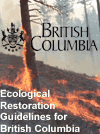 |
|
Natural Range of Variability The natural range of variability refers to the spectrum of ecosystem states and processes encountered over a long time period (Gayton 2001). Because so many ecosystems have been altered by European settlement, the "natural" range of variability usually refers to the full range of ecosystem structures and processes encountered before major changes brought by non-aboriginal humans. The natural range of variability is typically defined by the period 100-200 years before European settlement, and is also surmised from knowledge of natural disturbance regimes. Natural range of variability is often used to describe disturbance processes, and the ecosystem variability that these disturbances create. Ecosystems are thought to be more sustainable if we manage them so that their current disturbance regime falls within the natural range of variability (Gayton 2001). An example from studies of fire ecology shows how the natural range of variability concept works (Gayton 2001). Lewis Ridge, a dry, south-facing Douglas-fir forest near Cranbrook, had a historic fire return interval (the length of time between fires) that varied between 3 and 52 years, for the period 1600-1880. The average return interval was 19 years. If our restoration prescriptions call for fire every 2 years, or 80 years, or if over time the average interval between fires is shifted to 10 years or to 50 years, we can be said to be managing Lewis Ridge outside of its natural range of variability. However, if we were to use Lewis Ridge as a template for large-scale, fire-maintained ecosystem restoration in this forest type, we would not attempt to impose a 19-year fire return interval over the entire landscape. Instead we would create a mosaic of short, medium and long-return patches that collectively bring the average interval to near 19 years (Gayton, 2001). This landscape scale perspective is important, and will help restorationists restore the variability that was once present over space and time, rather than setting the same restoration target across the whole landscape. Of course, difficulties will arise when attempting to fit natural ranges of variability into modern concerns of a changing climate. If indeed the climate is warming, climate change concepts must then be applied as best as possible into restoration processes. A natural range of variability should be developed not only for the disturbance return interval but also for the size and severity of the disturbance (Gayton 2001). Enhancement versus Restoration
The words enhancement and restoration are
often used interchangeably, but the difference is important, and
relates to the natural range of variability. Enhancement often refers
to the manipulation of habitat to allow a selected species to exceed
its historical population levels in a particular area (Gayton 2001).
Enhancement activities attempt to change a habitat type or species
to outside its natural range of variability, usually for the benefit
of humans. A potentially negative example of enhancement is stocking
alpine lakes or stream reaches above waterfalls with economically
important fish species. As a result of these ecosystem changes negative
consequences are often suffered by the non-target species. |
||||
 

 
|
|||||
|
|
|||||
